Paisan Blu-ray Movie
HomePaisan Blu-ray Movie 
Paisŕ / Original Release VersionCriterion | 1946 | 126 min | Not rated | No Release Date
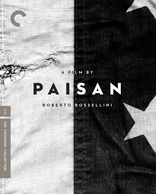
Price
Movie rating
7.4 | / 10 |
Blu-ray rating
| Users | 0.0 | |
| Reviewer | 4.5 | |
| Overall | 4.5 |
Overview
Paisan (1946)
Six episodes set across Italy during the country's liberation at the end of World War II examine the struggles of different cultures to communicate and of people to live their everyday lives.
Starring: Carmela Sazio, Robert Van Loon, Benjamin Emanuel, Raymond Campbell (I), Harold WagnerNarrator: Giulio Panicali
Director: Roberto Rossellini (I)
| Foreign | Uncertain |
| Drama | Uncertain |
| War | Uncertain |
Specifications
Video
Video codec: MPEG-4 AVC
Video resolution: 1080p
Aspect ratio: 1.37:1
Original aspect ratio: 1.37:1
Audio
Italian: LPCM Mono
Subtitles
English
Discs
50GB Blu-ray Disc
Single disc (1 BD)
Playback
Region A (locked)
Review
Rating summary
| Movie | 4.5 | |
| Video | 4.5 | |
| Audio | 4.5 | |
| Extras | 3.5 | |
| Overall | 4.5 |
Paisan Blu-ray Movie Review
Reviewed by Dr. Svet Atanasov July 16, 2017Roberto Rossellini's "Paisan" (1946) arrives on Blu-ray courtesy of Criterion. The supplemental features on the disc include an archival video introduction by the Italian director; archival video interview with renowned Italian film historian and critic Adriano Apra; video essay by film scholar Tag Gallagher; and more. Also included with the release is an illustrated booklet featuring essays by critics James Quandt, Irene Bignardi, Colin McCabe, and Jonathan Rosenbaum. In Italian, with optional English subtitles for the main feature. Region-A "locked".
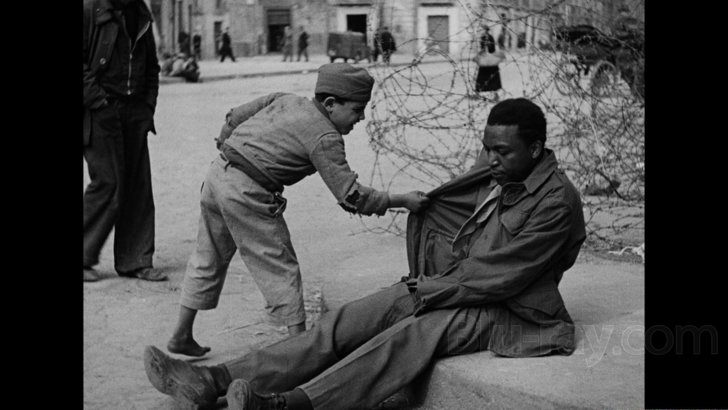
Come with me
Note: Paisan is part of Criterion's upcoming Roberto Rossellini's War Trilogy three-disc Blu-ray box set.
The second film in Roberto Rossellini’s acclaimed War Trilogy, Paisan, is structured as a collection of six vignettes, each introducing new characters but without ever choosing any stars. It functions as a documentary feature whose goal is to give the viewer an authentic sense of the dangerous chaos during the final days of WW2.
Prior to each vignette a narrator addresses the ongoing clashes between the Nazis, the Allies and occasionally scattered groups of Italian partisans. The descriptions are short, mostly factual and delivered with a clear patriotic tone. Raw archival footage from the fierce battles is also used as evidence that the narrator’s descriptions are accurate.
The different characters that emerge in each vignette are never given a chance to establish any sort of an intimate relationship with the viewer, but through a series of events their typically desperate situations leave a lasting impression. For example, in liberated Naples a drunken American soldier has his boots stolen by a cheeky orphan and when later on he visits the ruins where the boy lives he is so overwhelmed by the misery that he witnesses there that his only rational reaction is to run away. (This is obviously a man who has been in numerous battles and seen fellow soldiers die). In Rome a beautiful Italian girl who has been making ends meet as a prostitute picks up a slightly drunk American soldier and then rents a room in a rundown hotel to spend the night with him, but shortly after she discovers that he has been looking for a local girl that he met and fell in love with when he first arrived in the city -- and before the night is over she realizes that she is his ‘dream girl’ but he can no longer recognize her. In an old castle in the countryside a Sicilian girl and an American soldier also become attracted to each other despite the fact that they can use only a few words to communicate, but their unusual bond is tested when a group of Nazi soldiers discover their hiding place. Perhaps the most visually striking footage is from occupied Florence where an American nurse decides to begin searching for her boyfriend, an Italian partisan, who was last seen in an area of the city where fierce street battles are still underway. Here some of the panoramic vistas are every bit as extraordinary as the ones seen in Germany Year Zero.
Excluding the short exchanges between the three American soldiers and the monks in the secluded monastery where Rosseliini temporarily shifts the focus of attention to a different conflict -- here the whole concept of liberation is placed in a new context after the monks discover that two of their guests are of different faith and begin praying for their salvation -- the film most certainly works as intended. It is an eye-opener for anyone looking to understand the unpredictable dynamics of the final stage of a global war that was fought by people from different cultures that were united by a common goal.
Rossellini used a very large number of non-professional actors and some lesser known and up-and-coming actors. Unsurprisingly, at times the performances can be a bit uneven. A young Federico Fellini, who contributed to the script for the film and served as a second assistant director, can be spotted in the third vignette.
Paisan Blu-ray Movie, Video Quality 
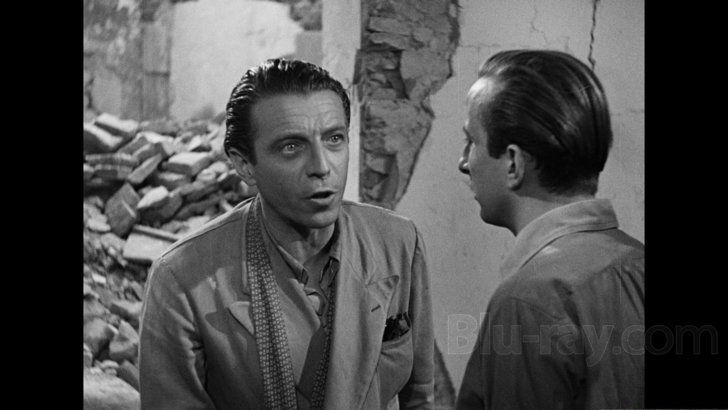
Presented in its original aspect ratio of 1.37:1, encoded with MPEG-4 AVC and granted a 1080p transfer, Roberto Rossellini's Paisan arrives on Blu-ray courtesy of Criterion.
The following text appears inside the booklet provided with this Blu-ray release:
"This new digital restoration of Paisan was created in 2K resolution from a 35mm fine-grain positive preserved by Cineteca Nazionale, with the consultation of Tag Gallagher. The original monaural soundtrack was remastered from the 35mm optical soundtrack positive."
As it is the case with the other two films in the War Trilogy some minor specks, scratches, and traces of natural fading and wear remain, so there are areas where fluctuations in terms of density, clarity, and depth are obvious. However, the overall quality of the current presentation is very good. Indeed, where time has not irreversibly damaged the original film elements the quality of the visuals range from very good to excellent (you can see examples in screencaptures #1 and 2). The grading is also very convincing -- the blacks are solid and natural, never appearing artificially boosted, while the whites and grays are nicely balanced. There are no traces of problematic degraining or sharpening adjustments, though you will notice some small fluctuations because of reasons highlighted above. Also, during the raw footage that is used with the narration additional native fluctuations can be seen (see screencapture #13). Image stability is very good. Minor reel unevenness and and a few jumps remain, but overall stability is not compromised. (Note: This is a Region-A "locked" Blu-ray release. Therefore, you must have a native Region-A or Region-Free player in order to access its content).
Paisan Blu-ray Movie, Audio Quality 
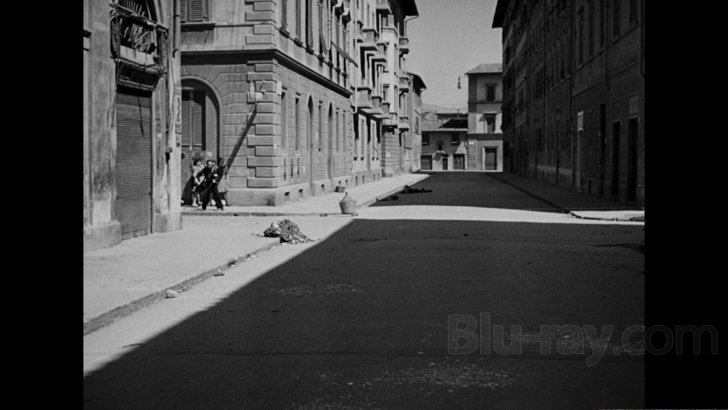
There is only one standard audio track on this Blu-ray release: Italian LPCM 1.0 (with small portions of English and German). There are optional English subtitles for the Italian dialog, but not for the exchanges in English.
The audio has been cleaned up as best as possible and as a result there are no distracting distortions or other severe issues. This being said, minor unevenness and flatness are present, but these are the type of source limitations that can no longer be fully eliminated with existing digital technology. In other words, while some very minor age-related imperfections remain, the basic qualities of the original audio are indeed restored.
Paisan Blu-ray Movie, Special Features and Extras 
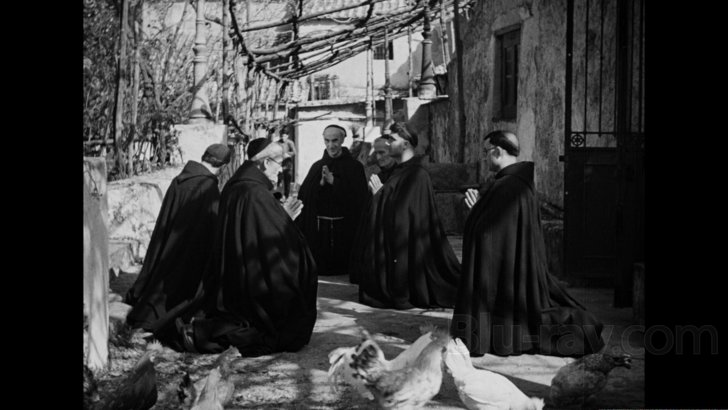
- Introduction - presented here is an archival introduction by Roberto Rossellini which was filmed for Roberto Rossellini Presents, a 1963 French television series introducing his films. It was directed by Jean-Marie Coldefy. In French, with optional English subtitles. (4 min, 1080p).
- Adriano Apra - presented here is an archival video interview with renowned Italian film historian, teacher, and critic Adriano Apra in which he explains how the original idea for Paisan evolved (with some specific comments about the script for the film), and discusses Federico Fellini's involvement with the film, the shooting process, the similarities between the liberation of Italy that was initiated by the Allies and the Risorgimento, the film's groundbreaking structure, etc. The interview was conducted exclusively for Criterion in 2009. In Italian, with optional English subtitles. (17 min, 1080i).
- Rossellini at Rice University - presented here are excepts from a video-taped discussion with Roberto Rossellini at Rice University in which he addresses the main qualities of his films (and specifically the critics' use of the term neorealism to describe them), some of the key themes that are channeled through them, and his fondness of non-professional actors. Leading the discussion is James Blue, then dierctor of Rice Media Center. Also present are professors Colin Young and David MacDougall. The discussion was held in 1970. In English, not subtitled. (14 min, 1080i).
- Into the Future - presented here is a video essay in which Roberto Rossellini scholar Tag Gallagher offers an in-depth analysis of the films in the War Trilogy and the era they representative of. In English, not subtitled. (31 min, 1080i).
- Booklet - an illustrated booklet featuring essays by critics James Quandt, Irene Bignardi, Colin McCabe, and Jonathan Rosenbaum.
Paisan Blu-ray Movie, Overall Score and Recommendation 

The second film in Roberto Rossellini's War Trilogy, Paisan, chronicles the arrival of the Allies in Calabria and then the gradual liberation of Italy as they moved up north. However, the film actually focuses on the difficult communication between the liberators, the partisans and ordinary Italians, rather than the dynamics of the many battles that were fought along the way. Paisan has been recently restored and looks great in high-definition. It is included in Roberto Rossellini's War Trilogy three-disc Blu-ray box set, which is distributed by Criterion. HIGHLY RECOMMENDED.
Similar titles
Similar titles you might also like
(Still not reliable for this title)

Germany Year Zero
Germania anno zero
1948

Rome, Open City
Roma cittŕ aperta
1945

Bicycle Thieves
Ladri di biciclette
1948

Accattone
1961

L' Avventura
1960

La Dolce Vita
1960

The Conformist
Il Conformista | 4K Restoration
1970

Mamma Roma
1962

Stalingrad
1993

Umberto D.
1952

Nights of Cabiria
Le notti di Cabiria
1957

8˝
Otto e mezzo / Federico Fellini's 8˝
1963

Il Generale della Rovere
Director's Cut | Includes theatrical cut in SD
1959

The Marriage of Maria Braun
Die Ehe der Maria Braun
1978

The Painted Bird
Nabarvené ptáce / Slipcover in Original Pressing
2019

Like Someone in Love
ライク・サムワン・イン・ラブ / Raiku samuwan in rabu
2012

The Great Beauty
La grande bellezza
2013

Ivan's Childhood
Ива́ново де́тство / Ivanovo detstvo
1962

The Night of the Shooting Stars
La notte di San Lorenzo
1982

I Knew Her Well
Io la conoscevo bene
1965